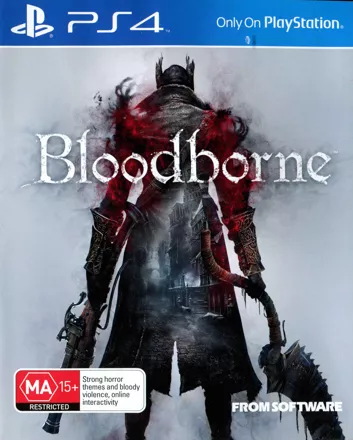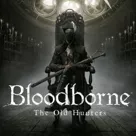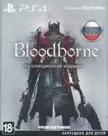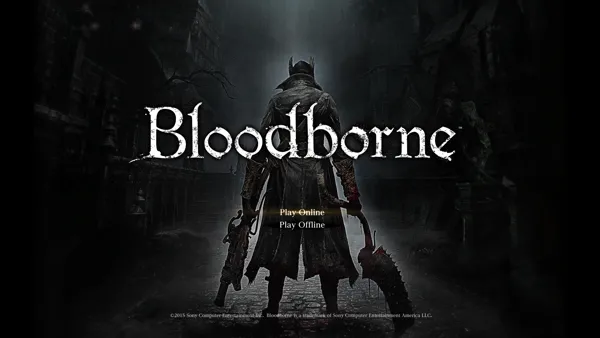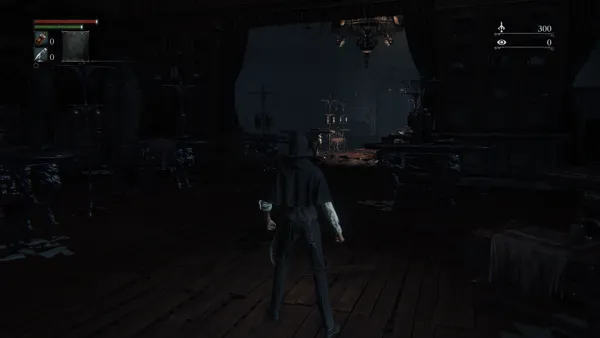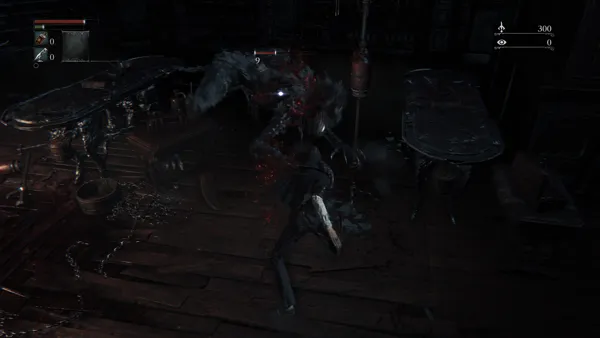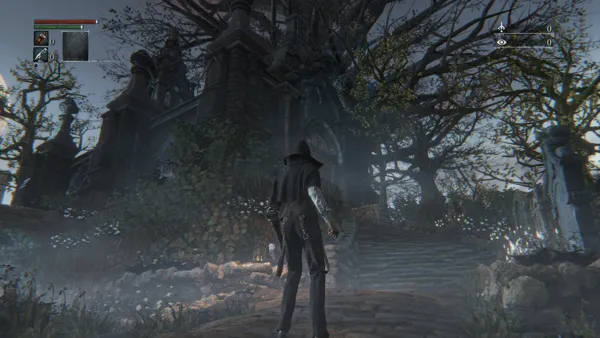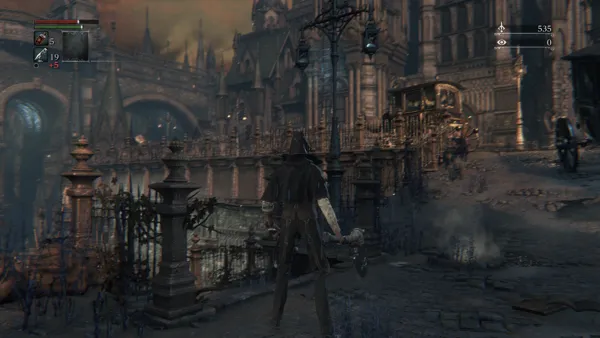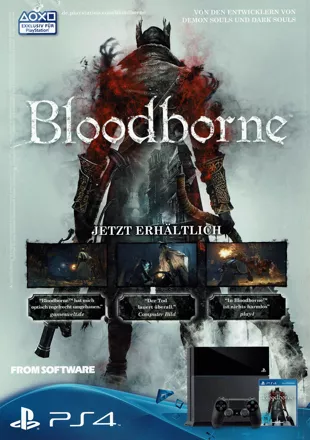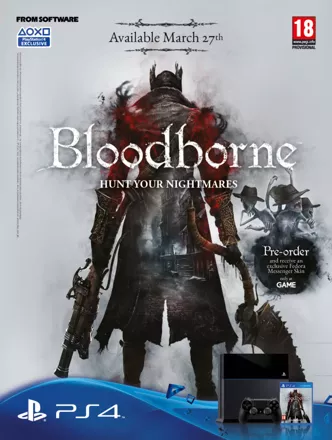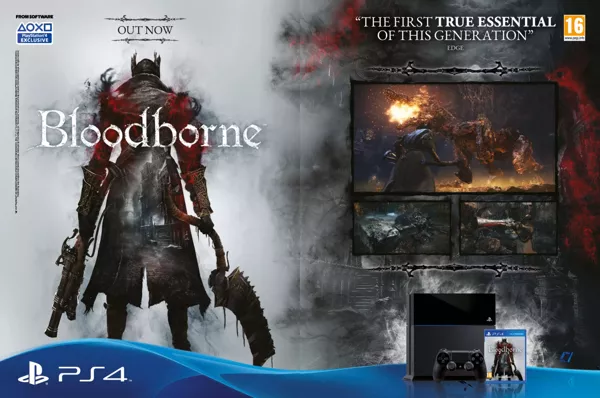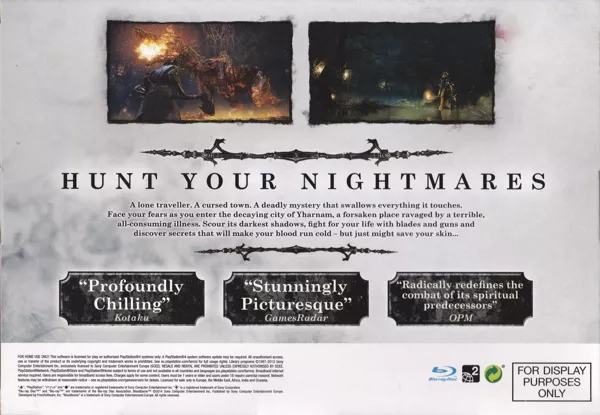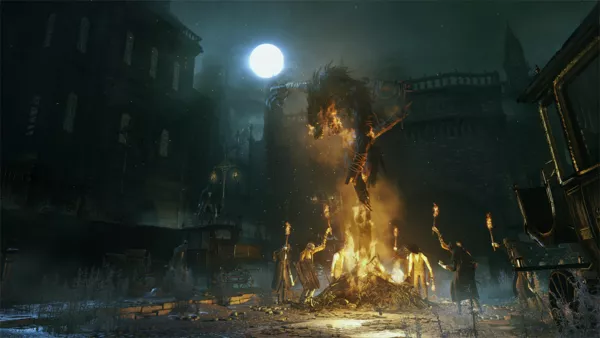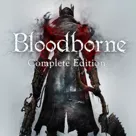Bloodborne
Description official description
Bloodborne is an action RPG that builds on the mechanics of the developer's earlier games Demon's Souls series and the Dark Souls series series. This title has Gothic and Victorian influences and it is set in the fantasy city Yharnam. The player's character is one of the many travelers who go there to seek a cure for their ailments. The character creation process is a contract ledger at a clinic prior to a blood transfusion with the remedy. When the character wakes up it is discovered the entire city is overrun by an illness that has transformed the citizens into violent creatures. The character gets to explore the city in a non-linear way, meeting various inhabitants and defeating monsters to survive.
At the start, a custom character can be created by defining a name, age, gender, origin, and appearance. The starting statistics are a general starting level, starting blood echoes (the main currency), discovery (loot drop frequency), vitality, endurance, strength, skill, bloodtinge, and arcane. The latter three influence who damages scales for certain builds. Origin replaces a general class system with different values for the statistics and a short back story. The available origins are Milquetoast, Lone Survivor, Troubled Childhood, Violent Past, Professional, Military Veteran, Noble Scion, Cruel Fate, and Waste of Skin.
Early on in the game Hunter's Dream is discovered, a location in another realm that acts as a central hub similar to The Nexus in Demon's Souls. It is possible to warp there from the main game world after locating lamps. These lamps replace the bonfires of the previous games and it is still only possible to save at those locations. The hub has different messengers to buy and sell items, a workshop to upgrade and repair weapons, storage for inventory management, and a memory altar (through Caryll Runes). Through the Headstones of Awakening, it is possible to warp to different parts of the world and Ritual Altars to access the Chalice Dungeons. These dungeons are randomly generated dungeons away from the main city players can explore. Layouts can also be shared or be found online. The two main characters in Hunter's Dream are the wheelchair-bound Gehrman who provides advice and the life-size doll called Doll who helps level up. Next to the hub world, it has the interconnect world known from the Dark Souls games.
Gameplay for combat, movement and exploration is largely similar to the Souls games. The weight statistic has been removed, there is less focus on defense and spells, and more on dodging. Rather than holding down a button, dodging is now an active and timing-based skill. The stamina bar is now more forgiving for multiple actions in succession. The amount of gear is more limited and the statistics are downplayed in favour of fighting skills for specific weapons. The main-hand weapon is generally melee while the off-hand usually holds a firearm mainly for combos and to riposte counter. An aggressive approach is rewarded through a new Regain system where certain attacks are rewarded with health after being hit, removing the need to run away and heal before continuing the fight. Generally, health is restored through vials (found or purchased), replacing flasks in the previous games. Through the Insight stat enemy placement and attacks are influenced. Reaching a certain level also often brings new elements into the game world and changes how the world reacts to the protagonist. Some enemies are able to absorb souls, forcing you to reclaim them. Insights is also used as a currency to buy special items and are required to summon other players. Next to the main weapons, there are ten trick weapons, very powerful ones that have two forms that can be switched on the fly.
The online element is similar to the previous titles. Allies can be summoned in your world and it is possible to invade other people's world. Up to three players can play cooperatively (not with private lobbies and passwords) and PvP is one-on-one. PvP is accessible after gaining an Insight rating of 30. Game elements include memoirs, asynchronous notes left behind, spectral appearances as illusions providing tips, and elements that show where other characters died.
Spellings
- ブラッドボーン - Japanese spelling
Groups +
Screenshots
Promos
Videos
Add Trailer or Gameplay Video +1 point
See any errors or missing info for this game?
You can submit a correction, contribute trivia, add to a game group, add a related site or alternate title.
Credits (PlayStation 4 version)
1,116 People (1,042 developers, 74 thanks) · View all
| Director | |
| Lead Programmer | |
| Programmers |
|
| [ full credits ] | |
Reviews
Critics
Average score: 93% (based on 20 ratings)
| Critic [ Expand All ] | Platform | Score |
|---|---|---|
| Anime News Network | PlayStation 4 | 100% |
| Jimquisition, The | PlayStation 4 | 100% |
| Digitally Downloaded | PlayStation 4 | 100% |
| Loot Gaming, The | PlayStation 4 | 99% |
| GameAwards.ru | PlayStation 4 | 96% |
| Games Finder | PlayStation 4 | 95% |
| Electronic Gaming Monthly (EGM) | PlayStation 4 | 95% |
| GameQuarter | PlayStation 4 | 95% |
| Gamegravy | PlayStation 4 | 95% |
| MAN!AC / M! Games | PlayStation 4 | 94% |
| Gameplay (Benelux) | PlayStation 4 | 93% |
| Hey Poor Player | PlayStation 4 | 90% |
| 4Players.de / 4P: Das Spielemagazin | PlayStation 4 | 90% |
| Wizard Dojo | PlayStation 4 | 90% |
| Games TM | PlayStation 4 | 90% |
| RPG Site | PlayStation 4 | 90% |
| Destructoid | PlayStation 4 | 90% |
| PSX Extreme | PlayStation 4 | 88% |
| Video Chums | PlayStation 4 | 87% |
| Computer Bild Spiele | PlayStation 4 | 82% |
| games xtreme | PlayStation 4 | Unscored |
Players
Average score: 4.5 out of 5 (based on 69 ratings with 1 reviews)
The Good
I’ve been playing From Software’s Souls series since the very beginning with the release of Demon’s Souls, and since then, my play-style has largely been the same. From title to title, I don a suit of plate armour, pick up straight sword and shield, and rigidly stick to that kit from beginning to end. Far from ambitious, I know, and sometimes I do become envious of players who are more creative with their weapons and apparel, but I guess I’m just happy in my comfort zone. However, it seems the creators of the series had issue with my little safety bubble since for the latest game, Bloodborne, everything has been rejiggered specifically to ensure that my beloved play-style is no longer a viable option. As it turns out, it’s going to take more than a calculated strike on my comfort zone to turn me off the series.
Make no mistake; while Bloodborne’s title no longer references souls (largely just swapping that word out for “blood” at every opportunity), it is a true-blue member of the Souls series. Anyone familiar with Dark or Demon’s Souls will spot the stark similarities immediately. From player movement, to UI, to multiplayer, to the hilariously floaty ragdolls, it carries all the best traits of the venerable franchise. There are, of course, a lot of changes, both large and small, but the list of what has stayed the same is most certainly a lot longer than what has been modified.
Like the games in the Souls series, you play as a character who awakens in a place with no memory of how they got there or what they’re supposed to do. This time around, rather than being set in medieval fantasy, you’re placed in the gothic-inspired city of Yharnam to find your purpose. The streets are desolate, walked only by shambling monstrosities and insane hunters. Anyone with any semblance of sanity left has barricaded themselves inside their homes and, for the most part, refuses to speak with you, merely referencing the hunt and often chastising you for not performing your role as hunter more expediently. As is the series’ tradition, rather than actually tell you the story, Bloodborne merely sits back and drops pieces for you to pick up and assemble along the way. It’s done largely without the use of cutscenes, instead providing it through cryptic snippets of dialogue and item descriptions. It’s a much more organic way to let the story unfold that harnesses the interactive medium in a way that many cutscene heavy games fail to.
Yharnam is a bleak visual treat. The series’ trademark morose atmosphere is thick in the city’s rain-wet, coffin-lined streets. Remarkably, the world gets continually darker and more nightmarish as the game progresses, though it doesn’t quite feature the environmental variety of its predecessors. Malformed men with makeshift weapons and firearms are soon replaced by lurching monstrosities and their grotesque friends, the statues that clutter the sidewalks change from plain, old-fashioned creepy cloaked figures to actually pretty distressing statues that seem to depict the final terrified moments of the populace, and the environments progress from familiar but ruined to unsettling and nightmarish. I never felt that the game became truly horrific, but there are a few uncomfortable images that have been burned into my memory.
While the changes in aesthetic, setting, and plot are largely superficial, the place where Bloodborne diverges furthest from the previous games is in its combat. Many small tweaks were made to make the combat flow better, and the result is a system that promotes aggression over a guarded defense. Attack combos flow together better, and health can be regained if an enemy is counter-attacked in time. Backstabbing has been removed, forcing you to either stagger an enemy with a well-timed shot from a secondary weapon or attacking it in a weak spot using a charged attack if you want a chance to land a critical strike. Weight restrictions have been removed, so every character build is nimble enough to dodge. All this makes battles, especially those against the boss monsters, more intense as combat requires quicker reflexes and better pattern recognition.
The Bad
The fact that Bloodborne carries so many stark similarities to previous games of the Souls series means that it can’t escape from comparisons with them, and, in many ways, its deficiencies will stick in the craw of some of the series’ fans.
More specifically, character building has been streamlined to a rather uncomfortable point. There are fewer attributes for you to spend your experience on, and similarly there are fewer weapon and armour options. With the removal of things like shields and heavy armour, defensive builds aren’t practical or even possible. Likewise, magic has been almost entirely ripped out, and what’s in its place is largely underwhelming. This isn’t to say that there’s no flexibility in how you build your character, but whenever player interaction would come up in previous Soul titles, you’d never really know what you were going to see since many players would often put together bizarre combinations of weapons and attire. This time around, it seems that everyone has simply rolled the same dude in a duster.
The series’ infamous unforgiving difficulty has also had its fangs pulled in some ways, as it’s much less of an inconvenience than before. Dying still sends you back to the last lantern you used, but there are so many shortcuts everywhere that even if you die on a boss, it’s typically only a short jog to get back to where you were. You still drop all of your unbanked experience when you die, but that’s it. Previous games coupled this with the loss of something else, such as your corporeal form in Demon’s Souls or your humanity in Dark Souls, but no equivalent exists in Bloodborne, and that takes away from the risk. The only real punishment for dying an embarrassing death this time around is having to sit through a vexingly long loading screen, which was even less tolerable before a patch shortened it.
While much of Bloodborne’s narrative hits the same notes as previous games in the series, it comes off as far weaker. You’re once again left picking through the ruins of a once grand civilization that was at one point lifted into the stratum by a grand secret that was its eventual undoing, but while the Souls series had legendary gods and kings, Bloodborne just has a sinister church and a nebulous university. Even when you reach these shadowy places, there doesn’t seem to be much that betrays their sinister purpose. There’s a psychological aspect to the game that suggests the focus was supposed to be on the player character, but they’re introduced into a mad world and any madness that’s piled on top of it could just be routine to them, for all we know. There also seems to be fewer sane NPC’s this time around, which may be a stylistic choice to add to the oppressive atmosphere, but without their own perspectives and backstories to flavour the pot, things are left a bit bland.
The Bottom Line
While Bloodborne never reaches the same dizzying heights of Dark Souls, it still retains the creative spark that made it so special. The dark atmosphere, the intense boss fights, and the minimalistic storyline still work to make a game that feels like nothing else out there on the market. There are attempts to take the series to new places by shifting the focus to combat and moving to a new setting, but surprisingly, it still feels a lot like the other games in From Software’s series. This sometimes works against it, as the game can feel limited in comparison to its predecessors, but make no mistake that Bloodborne is an OUTSTANDING game that’s well worth your time.
2 of 2 Moby users rated this review helpful.
Did you find this review helpful?
PlayStation 4 · by Adzuken (836) · 2015
Trivia
Sales
According to publisher Sony, Bloodborne has sold over 1 million copies worldwide since its initial release (as of April, 2015).
Awards
- EGM
- 2015 - ranked 3 (Top 25 of 2015)
- The Game Awards
- 2014 — Most Anticipated Game — Nominated
Analytics
Identifiers +
Contribute
Are you familiar with this game? Help document and preserve this entry in video game history! If your contribution is approved, you will earn points and be credited as a contributor.
Contributors to this Entry
Game added by Sciere.
Additional contributors: Alaka, Havoc Crow, CalaisianMindthief, Rik Hideto.
Game added April 11, 2015. Last modified March 14, 2025.


